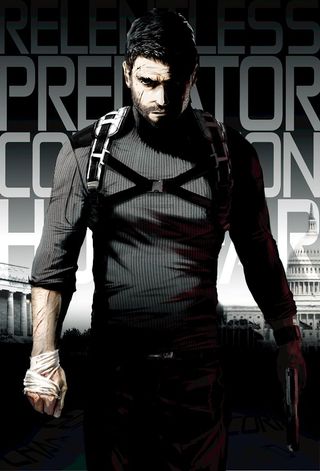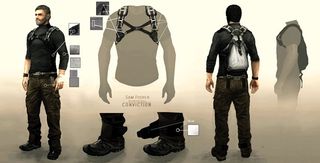The making of Splinter Cell: Conviction
Devs open up about the fall and rise of Sam Fisher
On a cold morning in January 2008, Maxime Beland entered Ubisoft’s Montreal studio, swiping his way through layer after layer of security, and sat down to begin work on Splinter Cell Conviction. Beland had wrapped up his work on Assassin’s Creed in the previous November and would be joining his colleague and new Conviction producer Alexandre Parizeau as Creative Director on a project in trouble.

A game of social stealth and hiding in plain sight, Conviction had been given its first showing to the world’s press nine months earlier and its last showing one month later in May of the same year. “It has to come out this year,” said Conviction’s original producer, Dany LePage, at that first showing: “There’s no other option.” The pressure to get the game right came from both inside and outside the studio; Ubisoft boss Yves Guillemot had taken it upon himself to personally announce the game at its debut and Microsoft was deeply invested in the 360/PC only title. It had demoed well on that Monday morning in Montreal but was a disaster at May 2007’s UbiDays event where it became clear the game was a long way from its planned autumn release.
“There were a lot of good ideas in the old direction,” says Beland. “It was really exciting, fresh, and a big challenge to deliver a game based on improvisation and being a fugitive.” French-accented like many at Ubisoft’s Montreal studio, Beland is softly-spoken but emphatic, and one of Ubisoft’s new generation of high-flyers. Starting in the testers’ room on Playmobil licenses Hype: The Time Quest and Alex Builds His Farm, Beland worked his way onto Rainbow Six 3 as a designer, then Rainbow Six Vegas and Assassin’s Creed as Creative Director. Now he filled the same role for Conviction.
As the months passed and the project grew more troubled, technical and creative problems became more apparent, as Beland explains: “Ubisoft felt the direction was maybe a bit too far from the core values of the brand. Alex and I joined the team in January and for two months we really tried to make that whole concept work, but I think there’s a point where you need to say well… we haven’t found it yet. And then maybe we need to change direction if we’re not achieving the level of quality we want.”


March 2008’s return to something more traditional meant much of what had been created would be thrown away. The original design focused on moving in crowds, improvisation, and complex interactions with objects and AI characters. New systems had been created from scratch and nine months of work had been invested in even the apparently simple job of how Sam would handle objects, but it was all work wasted on the new direction. “We tried to save as much as we could,” says Beland. “The script was brand new so the voice acting had to be redone. We reused a couple of art assets, a couple of level design assets… the cafe at the end of Lincoln Memorial and parts of Malta are also reused. All the engine and a lot of the lighting is old, though little of Unreal 2 is left because we’ve upgraded so much; I’d be surprised if there was 10% of Unreal code in there.”
Sam’s return to shadows and light meant years of work would go to waste, but also placed Parizeau’s team in the unenviable position of competing with Chaos Theory. Before the project’s reboot, both Dany LePage and original Senior Producer Mathieu Ferland had agreed that Shadow Stealth had run its course and gone as far as it could go. Chaos Theory was, as they had it, “perfect” and nothing more could be done with the idea.
When asked, Beland laughs: “You’ve played the game, right? I think there were things that could be done! To me the stealth action genre has always been delivered in a very non-permissive and difficult way. If you run, people are going to hear you and it’s game over; if a camera sees you, the alarm rings and it’s game over. This is okay but it’s old stealth to me. Everyone has that fantasy of the elite agent who uses stealth and tactics – like James Bond, Jason Bourne, Jack Bauer – so why do we in games make it so hardcore and difficult and non-permissive?” asks Beland. “Why do we have to make a game that only appeals to a certain number of people?”
Sign up to the GamesRadar+ Newsletter
Weekly digests, tales from the communities you love, and more

The idea was clear – if you’re the best in the world then you should feel like the best. Detection would no longer be an instant game over and fatalities would be a means justified by the end. Conviction would bring the same accessibility and openness to Splinter Cell that Beland brought to Rainbow Six with Vegas, and like Vegas it would all be at the risk of alienating existing fans. “Splinter and Rainbow shared this thing where the games are really good but they were really hardcore. The players who loved them were huge fans but at one point we had to ask ‘do we continue making the same game to please the same people when every time there’s less of them to please?’”

Helldivers 2's Joel gives cruelest Major Order yet as High Command eyes "disenfranchised families" as "cheap labor" to work on the dangerously sketchy new superweapon

Don't expect a big Mass Effect 5 update on N7 Day: BioWare warns that it's going to "be quieter" after Dragon Age: The Veilguard

Justice League Unlimited will be the "nexus" of the DC Universe - "Everything else happening revolves around the events in JLU"
Most Popular


